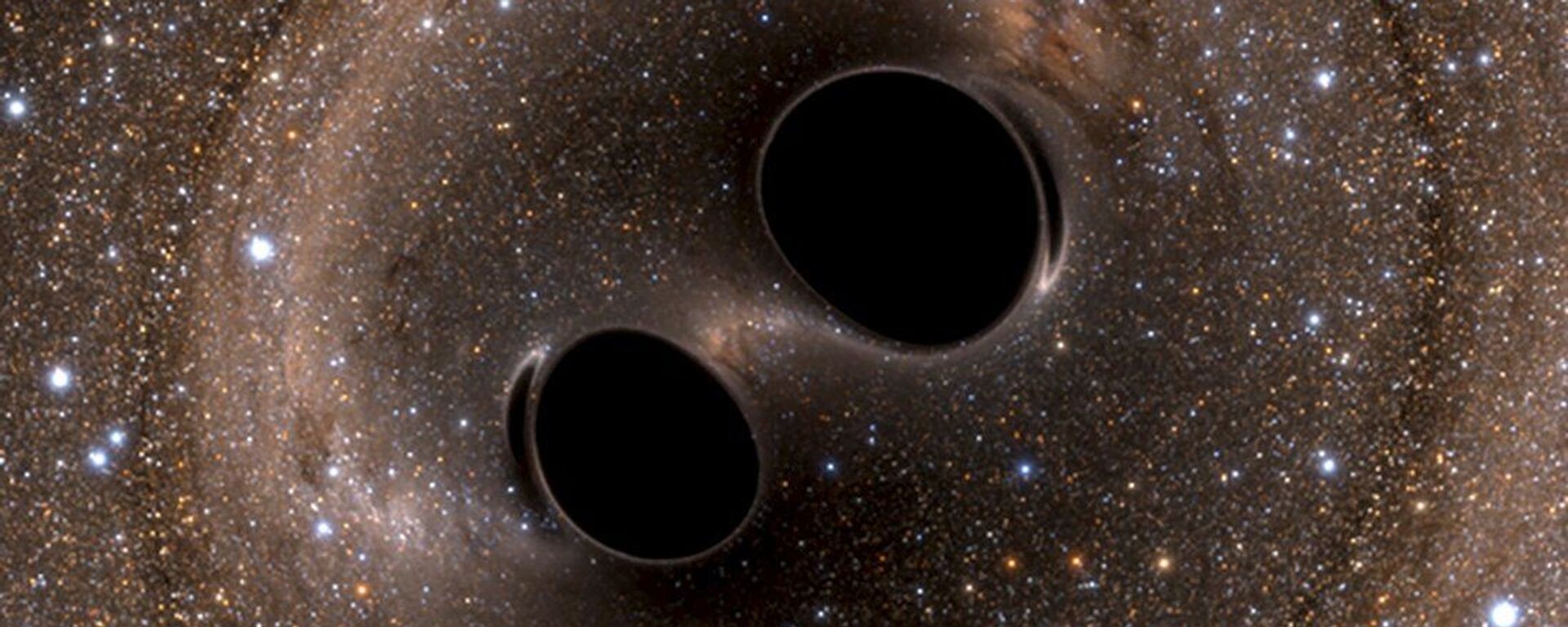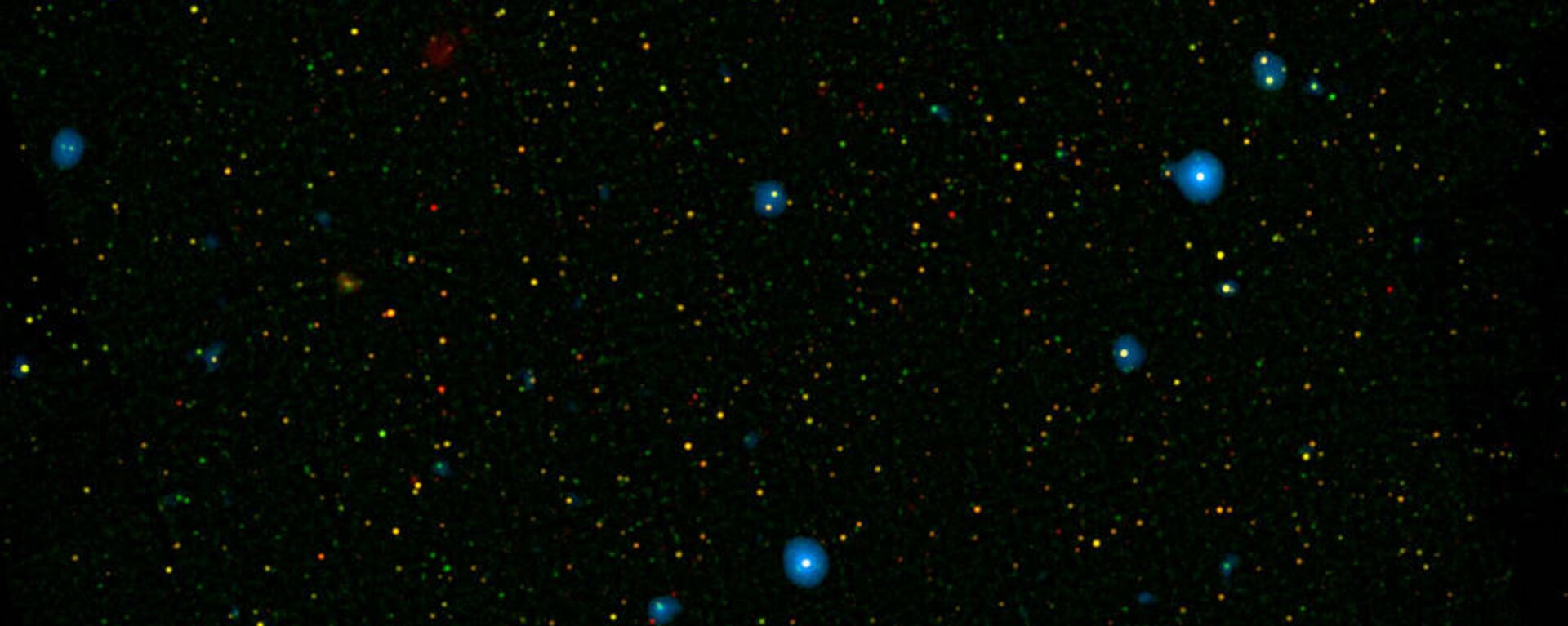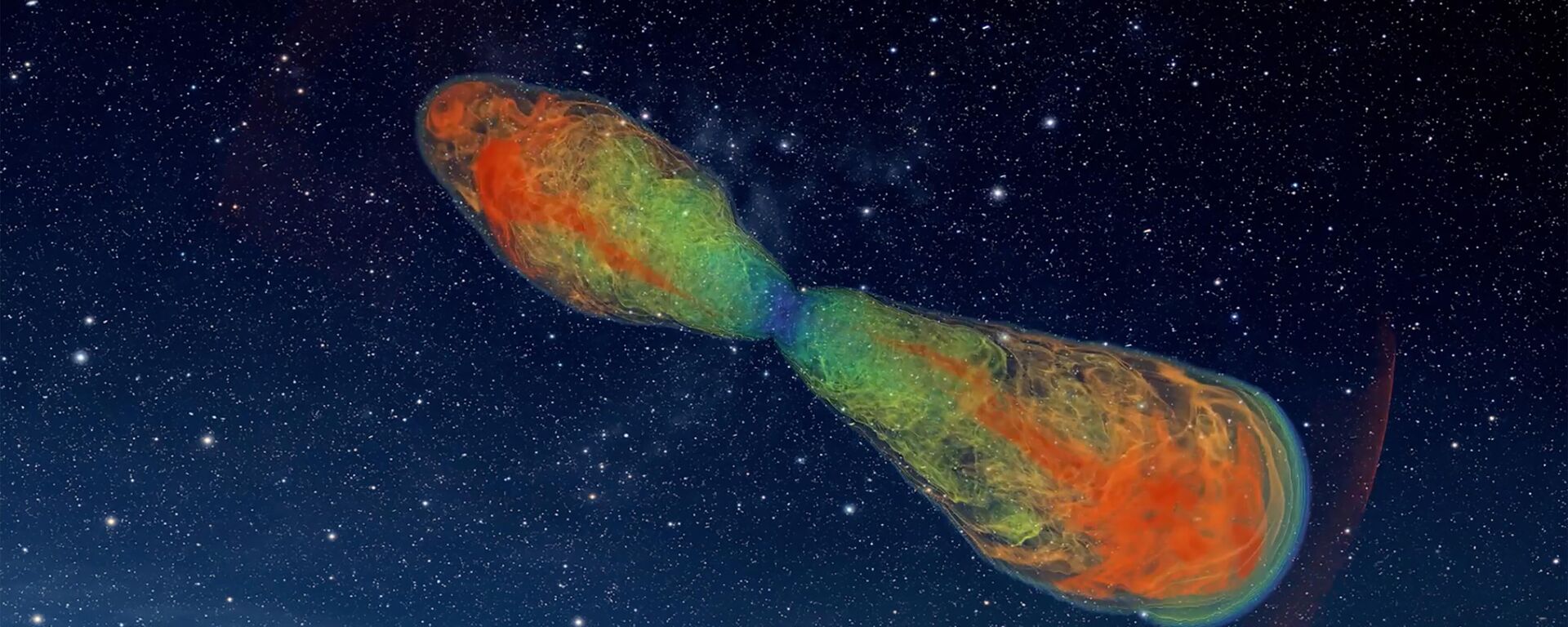https://sputnikglobe.com/20230629/scientists-discover-long-theorized-low-hum-created-by-supermassive-black-holes-1111535913.html
Scientists Discover Long Theorized 'Low Hum' Created by Supermassive Black Holes
Scientists Discover Long Theorized 'Low Hum' Created by Supermassive Black Holes
Sputnik International
Astronomers and astrophysicists have discovered evidence of Gravitational Wave Background signals, a long theorized type of energy emitted from supermassive black holes.
2023-06-29T02:59+0000
2023-06-29T02:59+0000
2023-06-29T02:58+0000
beyond politics
laser interferometer gravitational-wave observatory (ligo)
puerto rico
west virginia
earth
albert einstein
science & tech
gravitational waves
https://cdn1.img.sputnikglobe.com/img/07e6/08/15/1099808593_0:3:1281:723_1920x0_80_0_0_409cd33a39c5c9c2ce7d88fecc53e389.jpg
An international team of astronomers has discovered a faint hum that permeates the universe and will provide them clues about supermassive black holes, colliding galaxies and possibly the Big Bang.The North American Nanohertz Observatory for Gravitational Waves (NANOGrav) published a study on Wednesday showcasing evidence of the long theorized but never proven gravitational wave background (GWB) noise, a type of signal they believe emanates from supermassive black holes and colliding galaxies and may contain traces of the gravitational ripples caused by the Big Bang.Four of the study’s six papers were published in the Astrophysical Journal Letters, the remaining two have been accepted for publication at a later date. The discovery was first made in 2021, but the culmination of their work is just now being published.While GWB had been theorized before, no direct evidence had been found until now.Gravitational waves themselves are also technically a recent discovery. While they were first described in Einstein’s 1915 Theory of General Relativity, they had not been detected until 2015.While every piece of matter in the universe emits gravitational waves - most of them are undetectable - scientists can only hope to observe the effects of some of the largest bodies in the universe.That finally happened when the Laser Interferometer Gravitational-wave Observatory (LIGO) detected them for the first time in 2015. The LIGO shoots lasers down three-mile-long perpendicular tubes, with the hope that a gravitational wave will pass over it, causing one laser to shrink slightly while the other grows.Started in 1994 and first completed in 1997, the LIGO cost $395 million to build and didn’t detect any waves for the first 10 years of its existence. It shut down temporarily for a $200 million upgrade and renovation before finally detecting a gravitational wave that scientists believe came from two black holes, roughly 30 times the size of the sun each, colliding about 1.3 billion light-years from Earth.But LIGO is not capable of detecting GWB created by super massive black holes, which range from 100,000 to six billion times the size of the sun.So instead, the scientists at NANOGrav looked to the stars, or more specifically pulsars.They were able to distinguish the signal from other gravitational waves because of the pattern it passed through the pulsar. GWBs are unique from other gravitational waves because they come so close together they overlap. The researchers describe it by comparing it to hearing a crowd of people talking at once. At first, it sounds like a low consistent hum, until you concentrate and can pick out specific conversations.The same became true of GWBs once astronomers were able to detect the tiniest variations. Officials say they could predict the pulses from the pulsars down to 1 microsecond, the equivalent of measuring the distance of the moon within a thousandth of a millimeter.While scientists aren’t positive about the source of the GWB, it mirrored theories about the types of gravitational waves thought to be created by supermassive black holes.Scientists also say the rate of the waves is increasing, suggesting there may be hundreds or even thousands of supermassive black holes that have not yet been discovered. The signals may help us discover where some of these objects are and how they work, as well as provide scientists clues into the formation of galaxies and even the universe.Scientists previously feared supermassive black holes would never collide and just continually orbit each other; this was called the “final parsec problem” in the astrophysicist community.He adds if it is confirmed that the waves came from a supermassive black hole, “then they absolutely had to have passed the final parsec one way or another.”
https://sputnikglobe.com/20210116/humming-universe-hint-of-gravitational-wave-background-detected-as-study-probes-cosmic-mystery-1081786854.html
https://sputnikglobe.com/20221220/scientists-want-to-use-gravity-to-detect-alien-spacecrafts--1105628916.html
https://sputnikglobe.com/20230607/gravitational-waves-may-be-generated-from-debris-fields-around-dying-stars---study-1110969123.html
puerto rico
west virginia
earth
Sputnik International
feedback@sputniknews.com
+74956456601
MIA „Rosiya Segodnya“
2023
News
en_EN
Sputnik International
feedback@sputniknews.com
+74956456601
MIA „Rosiya Segodnya“
Sputnik International
feedback@sputniknews.com
+74956456601
MIA „Rosiya Segodnya“
supermassive black holes, the big bang, early universe, what happens when black holes collide, gravitational waves
supermassive black holes, the big bang, early universe, what happens when black holes collide, gravitational waves
Scientists Discover Long Theorized 'Low Hum' Created by Supermassive Black Holes
Scientific theories surrounding gravitational wave background signals may provide clues about the earliest days of the universe.
An international team of astronomers has discovered a faint hum that permeates the universe and will provide them clues about supermassive black holes, colliding galaxies and possibly the Big Bang.
The North American Nanohertz Observatory for Gravitational Waves (NANOGrav) published a study on Wednesday showcasing evidence of the long theorized but never proven gravitational wave background (GWB) noise, a type of signal they believe emanates from supermassive black holes and colliding galaxies and may contain traces of the gravitational ripples caused by the Big Bang.
Four of the study’s six papers were published in the Astrophysical Journal Letters, the remaining two have been accepted for publication at a later date. The discovery was first made in 2021, but the culmination of their work is just now being published.

16 January 2021, 11:11 GMT
While GWB had been theorized before, no direct evidence had been found until now.
Gravitational waves themselves are also technically a recent discovery. While they were first described in Einstein’s 1915 Theory of General Relativity, they had not been detected until 2015.
While every piece of matter in the universe emits gravitational waves - most of them are undetectable - scientists can only hope to observe the effects of some of the largest bodies in the universe.
That finally happened when the Laser Interferometer Gravitational-wave Observatory (LIGO) detected them for the first time in 2015. The LIGO shoots lasers down three-mile-long perpendicular tubes, with the hope that a gravitational wave will pass over it, causing one laser to shrink slightly while the other grows.
Started in 1994 and first completed in 1997, the LIGO cost $395 million to build and didn’t detect any waves for the first 10 years of its existence. It shut down temporarily for a $200 million upgrade and renovation before finally detecting a gravitational wave that scientists believe came from two black holes, roughly 30 times the size of the sun each, colliding about 1.3 billion light-years from Earth.
But LIGO is not capable of detecting GWB created by super massive black holes, which range from 100,000 to six billion times the size of the sun.

20 December 2022, 11:21 GMT
So instead, the scientists at NANOGrav looked to the stars, or more specifically pulsars.
Pulsars are dead stars, also known as neutron stars, that are highly magnetic and rotate roughly 700 times a second. Their spin is incredibly consistent and looks like flickering when observed from Earth. They are sometimes compared to lighthouses or clocks because of their consistency.
The NANOGrav astronomers watched pulsars for 15 years across different observatories in West Virginia, Puerto Rico, New Mexico and Canada, waiting for tiny variations that would indicate a gravitational wave from a supermassive black hole.
They were able to distinguish the signal from other gravitational waves because of the pattern it passed through the pulsar. GWBs are unique from other gravitational waves because they come so close together they overlap. The researchers describe it by comparing it to hearing a crowd of people talking at once. At first, it sounds like a low consistent hum, until you concentrate and can pick out specific conversations.
The same became true of GWBs once astronomers were able to detect the tiniest variations. Officials say they could predict the pulses from the pulsars down to 1 microsecond, the equivalent of measuring the distance of the moon within a thousandth of a millimeter.
“We are extraordinarily excited to see this pattern pop out finally,” said Stephen Taylor, a gravitational wave astrophysicist at Vanderbilt University, who co-led the research.
While scientists aren’t positive about the source of the GWB, it mirrored theories about the types of gravitational waves thought to be created by supermassive black holes.
Scientists also say the rate of the waves is increasing, suggesting there may be hundreds or even thousands of supermassive black holes that have not yet been discovered. The signals may help us discover where some of these objects are and how they work, as well as provide scientists clues into the formation of galaxies and even the universe.
Scientists previously feared supermassive black holes would never collide and just continually orbit each other; this was called the “final parsec problem” in the astrophysicist community.
“To get these types of high amplitudes that we are seeing, we need fairly massive black holes, and they need to form binaries [aka supermassive black holes] quite frequently and evolve quite efficiently,” Luke Zoltan Kelley, an assistant professor at the University of California, Berkeley who participated in the NANOGrav study, said in a statement.
He adds if it is confirmed that the waves came from a supermassive black hole, “then they absolutely had to have passed the final parsec one way or another.”







